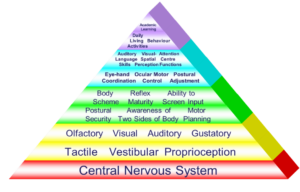How things are processed
Sensory processing refers to the brain’s ability to interpret information received from the senses, organise it in a meaningful way, and to create adaptive responses.
Adaptive response is defined as observable behaviour or reaction that is appropriate to the environment.
For example, a child covering their ears or cry due to a strong surprising sound is adaptive response, however when this behaviour is observed during a lesson, the reaction is not appropriate.
We are all familiar with the five senses: touch, taste, smell, sight and sound. In addition to these, the body also senses movement, the force of gravity and the position of our body through our muscles and joints. This is referred to as proprioception – the ability to sense our position in relation to the space around us.
The body also senses where the head is in relation to gravity and how it is moving. This keeps us upright and balanced. This sense is known as vestibular.
These two senses both give us information about the physical condition of our body and the environment.
The brain must organise all of these sensations to be able to make sense of what is around us to respond appropriately. These sensory processing mechanisms also provide a crucial foundation for more complex learning and behaviour.

